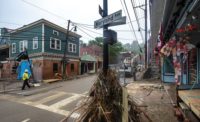Investigators Seek Answers to Anchor Failures on Minneapolis Bridge
Now that engineers have determined that a ruptured diaphragm plate led to the failure of a pair of cables on a 2,200-ft cable-stayed suspension bridge in Minneapolis, they are turning their attention to potential causes of the rupture, as well as fractures uncovered on two additional plates in late February.

Meantime, city officials say they are satisfied with results of an October inspection of the Martin Olav Sabo Bridge that assigned its 18 sets of cables and anchors the highest possible rating for soundness and lack of corrosion. The four-year-old bicycle and pedestrian bridge also received top ratings in previous inspections, which are performed annually and primarily rely on visual analysis, says Minneapolis Director of Public Works Steve Kotke.
On Feb. 19, a diaphragm plate and two of the bridge's longest support cables were discovered lying on the deck, prompting closure of the structure. Less than a week later, city crews removed a second pair of cables after fractures were uncovered on a second plate. A day later, fractures were discovered on a third plate.
Kotke would not confirm reports indicating the ruptured plate was partially rusted. “During normal inspections we look for rust. Rust is something you expect to see, but we don't know whether rust or corrosion caused the plate to fail,” he says.
Northbrook, Ill.-based engineer Wiss Janney Elstner Associates has completed inspection of the remaining 15 plates and is investigating the cause of the plate fractures. The bridge's designer, San Francisco-based URS Corp., is consulting on plans to remove the fractured plates, says Deputy Director of Public Works Heidi Hamilton.
Once removed, the plates will be shipped to Bethlehem, Pa.-based Le High University, where they will undergo analysis by John W. Fisher, professor emeritus of civil engineering.
Hamilton says it may take two months to determine the cause of the plate fractures. The initial rupture was of particular significance because it involved the top set of cables on the east end of the structure's 100-ft-high pylon. The cables support a larger section of the bridge than cables located on the west side.
Hennepin County undertook construction of the $5.1-million bridge, but transferred ownership of the structure to the City of Minneapolis in 2008, a year after it was completed. A 220-ft span facilitates continuous biking across the city while accommodating vehicular and light-rail travel on Hiawatha Ave. below.
Hiawatha was reopened after temporary shoring was installed on the east end of the structure. The bridge remains closed.
Investigaters seek the information about failures of minnepolies bridge.<br/>What is the reason they got about failure?<br/>Thank you<br/>Bizworldusa
What is the reason they got about failure?
Thank you
Bizworldusa




